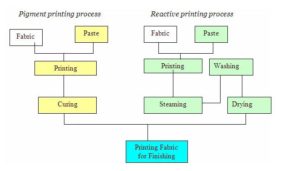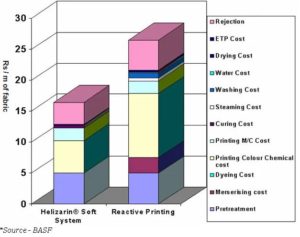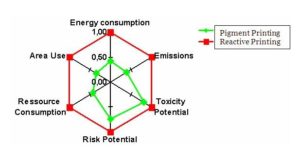Ecological & Cost-Efficient
Textile Printing Technology
Textile Printing Technology
Cotton is the worlds most widely consumed fiber, with a total of 26 million tons consumed worldwide annually (1). It is cool, soft, and comfortable and is the principal clothing fiber of the world. The cotton production industry has major impacts on the prosperity and economic stability of the cotton producing countries. More than 30% of cotton is consumed as a printed fabric. In the textile industry more than 78% of the printed goods are of cotton fabric and it has been used for the apparel and home furnishing since centuries (2). Therefore, the importance of textile printing must not be overlooked.
Textile Printing
There are different ways of printing on the textile fabric. Some common methods – include:
- Direct printing
- Discharge Printing
- Resist Printing
Direct printing is the most common and traditional way of printing in the textile industry. It is also the simplest method of printing and the percentage of wastage (damage) is minimal. There are different techniques for direct printing like Pigment Printing, Reactive Printing, VAT printing. The first two methods of direct printing are used by the fashion industry around the world while VAT printing is used for making army uniforms.
Pigment or Reactive printing which is better and why? This has always been the subject of discussion among the industry experts. But in recent years, pigment printing emerges as the best method of printing.
Advantages of Pigment Printing
- Any mistakes can be easily detected and rectified during the printing process.
- Sampling is very fast.
- Very short process of printing and fixation.
- High light fastness and dry-cleaning fastness.
- Very low percentage of rejections.
- No staining on the white ground.
- No mercerizing necessary.
- It is the most economical way of printing.
- Most environment-friendly.
- It can be applied on any substrate (Cotton/Polyester/Nylon/Glass fiber).
Steps in the printing processes

Myth: Reactive printing is always more brilliant and softer than pigment printing.
With todays advanced textile printing technology, it is not true that the effects of reactive printing are more desirable than pigment printing. BASF offers the latest technology in textile printing system, a unique combination that achieves the effects of soft, vibrant prints at the lower cost and simpler process of pigment printing the Helizarin Soft System.
Helizarin Soft System is creatively designed to take over the advantages of reactive printing. It can produce pigment prints with
- fastness properties equal to or better than reactive prints
- excellent brilliancy
- excellent handle
Helizarin Soft System is a combination of 3rd GenEx binders which are much softer than ordinary binders and Luprintol Multifunction CF which is a mixture of emulsifiers plus fixing agent, giving better evenness to print and improved fastness. Luprintol Soft VSN is a unique mixture of softener and plasticizer, which provides results similar to the reactive printed fabric.
Cost advantage of Helizarin Soft System over Reactive Printing:
Helizarin Soft System uses at least half the amount of printing paste compared to reactive printing, thus lowering the per meter cost of colour and chemicals significantly.
In reactive printing, intense washing is required to remove the natural or synthetic thickener and hydrolyzed dyes from the fabric, which consumes large volumes of water (12-14 liters per kg of fabric) and also energy. On the other hand, Helizarin Soft System does not require washing but is immediately cured after the printing process.


Energy, Time and Labor Saving is an added advantage when using Helizarin Soft System. Reactive printing requires washing and leads to subsequent drying which increases the time by approximately 30%. These two extra processes require more labor and energy.
Environmental Advantage of Helizarin Soft System:
As per the BASF ECOSOFT study, we know that energy consumption in pigment printing is 6.8 MJ/mt compared to 16.7 MJ/mt in reactive printing due to intense washing and drying of the reactive printed fabric. In Helizarin Soft System, the CO2 emission is reduced by almost 40% compared to reactive printing emissions.
Conclusion
Traditionally, the textile processing industry requires a lot of water for printing and dyeing, consuming much energy at the same time. However, with BASFs new solution, Helizarin Soft System, water consumption is reduced drastically as no washing is required, contributing positively to ecology and society. By putting FUTURE into Textiles, BASF is committed to Consumer Safety, Resource Saving and Climate Protection. Helizarin Soft System is a step towards a sustainable future.
End Note:
- The Fiber Year GmbH
- Industry Source / ITME